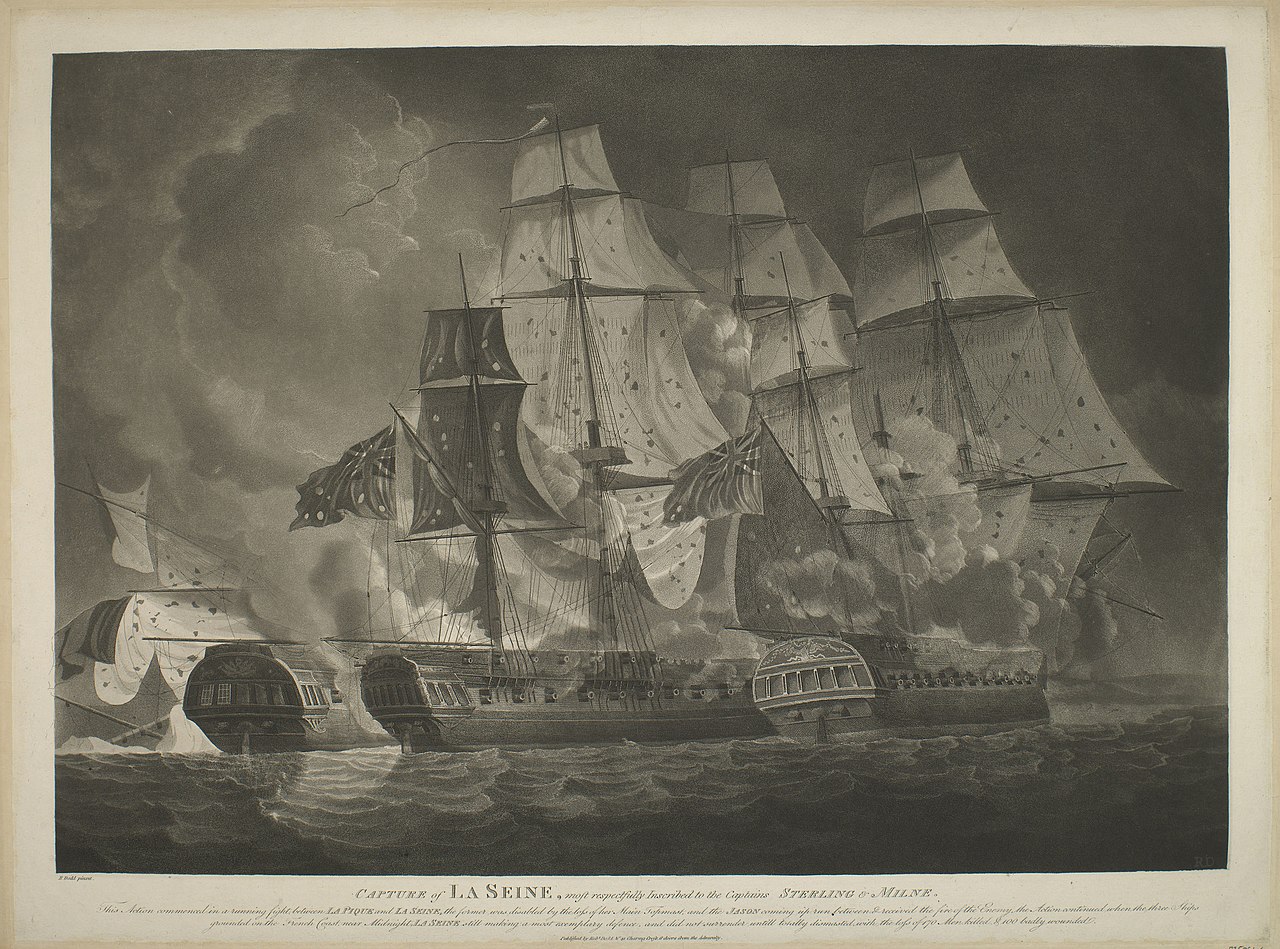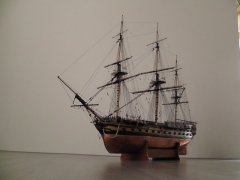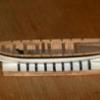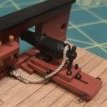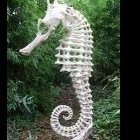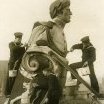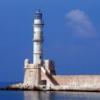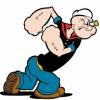-
Posts
2,245 -
Joined
-
Last visited
Reputation Activity
-
 Beef Wellington got a reaction from Sjors in HMS Jason by Beef Wellington - Caldercraft - 1:64 - Artois-class frigate modified from HMS Diana 1794
Beef Wellington got a reaction from Sjors in HMS Jason by Beef Wellington - Caldercraft - 1:64 - Artois-class frigate modified from HMS Diana 1794
Hi all,
Well finally been able to get some things done that tangibly move things forward. The area around the mainmast is one of the more interesting and complex areas to get situated. All of these items were scratchbuilt, which of course resulted in the usual re-does as the geometry is critical to get right as the pump axel and cranks need to align with minimal tolerances.
Capstan and aft coamings now glued into position, the deck beam needs to be modified to allow the capstan to be positioned appropriately.
Little bit of rework on the pumps, the simulated leather washer I had previously painted kept jumping out at me and was a little too 'in your face'. Stripped this off and went with what seems to be a more traditional modeling approach to use layer of wood to simulate the gasket and plug. Here they are in final position.
The main jeer bitts were then positioned first once the pumps were in place to finalise the dimensions of the middle pump brakes. The kit supplies some PE for these, but knew that these would never be satisfactory and have been planning to make my own. The supplied wire is around 0.8mm, so 1mm square styrene sections were drilled and cut to give a little more of an authentic look to the winches. To say this process is delicate and frustrating is an understatement - once drilled, the there is barely any structural strength to the styrene around the hole. The aft winches were made in one piece which allowed them to be aligned relatively easily and secured using thin CA which worked quite well. Once glued, the styrene was then gently filed to give a hint of the actual shape.
Rhodings were made out of boxwood and painted, to my eye this gave a little better scale look. The stanchions had been made previously, and notches cut into the deck beam to allow these to be secured.
The stanchions were finalized and installed...making the second curved bracing element to be the same as the first took a lot longer than expected.
The layout of the main topsail sheet bitts dictates that the winches need to made separately reflecting actual practice. These longer winches proved much more challenging than the shorter ones, and many were attempted before 2 acceptable ones were completed.
Elm tree pumps were shaped from boxwood stock, and the PE fittings came from an extra set I found left over from my Snake build. These were fun items to make up, but will not be finally fixed just yet as they are very delicate.
Overall shots with everything in place shows just how crowed this area really is. Overall, very happy with how this ultimately turned out. The main topsheet bitts align underneath the deck beam at the forward end of the quarterdeck.
Overlaying scaled copy from AOTS, one can get a good sense for the reason for the scuttles in the quarterdeck which would have been necessary to be able to remove the various pump shafts. I'm considering modding the quarterdeck to allow these scuttles to be left open to allow the pump mechanisms to be better seen.
-
 Beef Wellington got a reaction from Ronald-V in HMS Jason by Beef Wellington - Caldercraft - 1:64 - Artois-class frigate modified from HMS Diana 1794
Beef Wellington got a reaction from Ronald-V in HMS Jason by Beef Wellington - Caldercraft - 1:64 - Artois-class frigate modified from HMS Diana 1794
Hi all,
Well finally been able to get some things done that tangibly move things forward. The area around the mainmast is one of the more interesting and complex areas to get situated. All of these items were scratchbuilt, which of course resulted in the usual re-does as the geometry is critical to get right as the pump axel and cranks need to align with minimal tolerances.
Capstan and aft coamings now glued into position, the deck beam needs to be modified to allow the capstan to be positioned appropriately.
Little bit of rework on the pumps, the simulated leather washer I had previously painted kept jumping out at me and was a little too 'in your face'. Stripped this off and went with what seems to be a more traditional modeling approach to use layer of wood to simulate the gasket and plug. Here they are in final position.
The main jeer bitts were then positioned first once the pumps were in place to finalise the dimensions of the middle pump brakes. The kit supplies some PE for these, but knew that these would never be satisfactory and have been planning to make my own. The supplied wire is around 0.8mm, so 1mm square styrene sections were drilled and cut to give a little more of an authentic look to the winches. To say this process is delicate and frustrating is an understatement - once drilled, the there is barely any structural strength to the styrene around the hole. The aft winches were made in one piece which allowed them to be aligned relatively easily and secured using thin CA which worked quite well. Once glued, the styrene was then gently filed to give a hint of the actual shape.
Rhodings were made out of boxwood and painted, to my eye this gave a little better scale look. The stanchions had been made previously, and notches cut into the deck beam to allow these to be secured.
The stanchions were finalized and installed...making the second curved bracing element to be the same as the first took a lot longer than expected.
The layout of the main topsail sheet bitts dictates that the winches need to made separately reflecting actual practice. These longer winches proved much more challenging than the shorter ones, and many were attempted before 2 acceptable ones were completed.
Elm tree pumps were shaped from boxwood stock, and the PE fittings came from an extra set I found left over from my Snake build. These were fun items to make up, but will not be finally fixed just yet as they are very delicate.
Overall shots with everything in place shows just how crowed this area really is. Overall, very happy with how this ultimately turned out. The main topsheet bitts align underneath the deck beam at the forward end of the quarterdeck.
Overlaying scaled copy from AOTS, one can get a good sense for the reason for the scuttles in the quarterdeck which would have been necessary to be able to remove the various pump shafts. I'm considering modding the quarterdeck to allow these scuttles to be left open to allow the pump mechanisms to be better seen.
-
 Beef Wellington got a reaction from CDW in HMS Jason by Beef Wellington - Caldercraft - 1:64 - Artois-class frigate modified from HMS Diana 1794
Beef Wellington got a reaction from CDW in HMS Jason by Beef Wellington - Caldercraft - 1:64 - Artois-class frigate modified from HMS Diana 1794
Hi all,
Well finally been able to get some things done that tangibly move things forward. The area around the mainmast is one of the more interesting and complex areas to get situated. All of these items were scratchbuilt, which of course resulted in the usual re-does as the geometry is critical to get right as the pump axel and cranks need to align with minimal tolerances.
Capstan and aft coamings now glued into position, the deck beam needs to be modified to allow the capstan to be positioned appropriately.
Little bit of rework on the pumps, the simulated leather washer I had previously painted kept jumping out at me and was a little too 'in your face'. Stripped this off and went with what seems to be a more traditional modeling approach to use layer of wood to simulate the gasket and plug. Here they are in final position.
The main jeer bitts were then positioned first once the pumps were in place to finalise the dimensions of the middle pump brakes. The kit supplies some PE for these, but knew that these would never be satisfactory and have been planning to make my own. The supplied wire is around 0.8mm, so 1mm square styrene sections were drilled and cut to give a little more of an authentic look to the winches. To say this process is delicate and frustrating is an understatement - once drilled, the there is barely any structural strength to the styrene around the hole. The aft winches were made in one piece which allowed them to be aligned relatively easily and secured using thin CA which worked quite well. Once glued, the styrene was then gently filed to give a hint of the actual shape.
Rhodings were made out of boxwood and painted, to my eye this gave a little better scale look. The stanchions had been made previously, and notches cut into the deck beam to allow these to be secured.
The stanchions were finalized and installed...making the second curved bracing element to be the same as the first took a lot longer than expected.
The layout of the main topsail sheet bitts dictates that the winches need to made separately reflecting actual practice. These longer winches proved much more challenging than the shorter ones, and many were attempted before 2 acceptable ones were completed.
Elm tree pumps were shaped from boxwood stock, and the PE fittings came from an extra set I found left over from my Snake build. These were fun items to make up, but will not be finally fixed just yet as they are very delicate.
Overall shots with everything in place shows just how crowed this area really is. Overall, very happy with how this ultimately turned out. The main topsheet bitts align underneath the deck beam at the forward end of the quarterdeck.
Overlaying scaled copy from AOTS, one can get a good sense for the reason for the scuttles in the quarterdeck which would have been necessary to be able to remove the various pump shafts. I'm considering modding the quarterdeck to allow these scuttles to be left open to allow the pump mechanisms to be better seen.
-
 Beef Wellington got a reaction from Old Collingwood in HMS Jason by Beef Wellington - Caldercraft - 1:64 - Artois-class frigate modified from HMS Diana 1794
Beef Wellington got a reaction from Old Collingwood in HMS Jason by Beef Wellington - Caldercraft - 1:64 - Artois-class frigate modified from HMS Diana 1794
Hi all,
Well finally been able to get some things done that tangibly move things forward. The area around the mainmast is one of the more interesting and complex areas to get situated. All of these items were scratchbuilt, which of course resulted in the usual re-does as the geometry is critical to get right as the pump axel and cranks need to align with minimal tolerances.
Capstan and aft coamings now glued into position, the deck beam needs to be modified to allow the capstan to be positioned appropriately.
Little bit of rework on the pumps, the simulated leather washer I had previously painted kept jumping out at me and was a little too 'in your face'. Stripped this off and went with what seems to be a more traditional modeling approach to use layer of wood to simulate the gasket and plug. Here they are in final position.
The main jeer bitts were then positioned first once the pumps were in place to finalise the dimensions of the middle pump brakes. The kit supplies some PE for these, but knew that these would never be satisfactory and have been planning to make my own. The supplied wire is around 0.8mm, so 1mm square styrene sections were drilled and cut to give a little more of an authentic look to the winches. To say this process is delicate and frustrating is an understatement - once drilled, the there is barely any structural strength to the styrene around the hole. The aft winches were made in one piece which allowed them to be aligned relatively easily and secured using thin CA which worked quite well. Once glued, the styrene was then gently filed to give a hint of the actual shape.
Rhodings were made out of boxwood and painted, to my eye this gave a little better scale look. The stanchions had been made previously, and notches cut into the deck beam to allow these to be secured.
The stanchions were finalized and installed...making the second curved bracing element to be the same as the first took a lot longer than expected.
The layout of the main topsail sheet bitts dictates that the winches need to made separately reflecting actual practice. These longer winches proved much more challenging than the shorter ones, and many were attempted before 2 acceptable ones were completed.
Elm tree pumps were shaped from boxwood stock, and the PE fittings came from an extra set I found left over from my Snake build. These were fun items to make up, but will not be finally fixed just yet as they are very delicate.
Overall shots with everything in place shows just how crowed this area really is. Overall, very happy with how this ultimately turned out. The main topsheet bitts align underneath the deck beam at the forward end of the quarterdeck.
Overlaying scaled copy from AOTS, one can get a good sense for the reason for the scuttles in the quarterdeck which would have been necessary to be able to remove the various pump shafts. I'm considering modding the quarterdeck to allow these scuttles to be left open to allow the pump mechanisms to be better seen.
-
 Beef Wellington got a reaction from BenD in HMS Snake by BenD - Caldercraft - 1:64
Beef Wellington got a reaction from BenD in HMS Snake by BenD - Caldercraft - 1:64
Hi Ben, I also went with red in the hawse holes, mainly because it seemed consistent and brings a nice contrast which can be seen on many contemporary models. In reality, the holes would probably have been lined with lead sheet. Nice work on the headworks by the way!
-
 Beef Wellington reacted to Ahoy_there in HMS Trincomalee by Ahoy_there (Lin) - scale 1:72
Beef Wellington reacted to Ahoy_there in HMS Trincomalee by Ahoy_there (Lin) - scale 1:72
Hi fellow model makers it's been a very long time since I last posted. I got side tracked by another model because of doing a show at Bovingdon Tank Museum. I was also putting off what I thought was going to be really difficult. In my last post I was just starting to sculpt my figurehead. Well it's 3/4 finished I just have to sculpt the swirly material part and attach it but I thought I'd show you all an up to date pic (plus my distraction)
-
 Beef Wellington got a reaction from Sea Hoss in HMS Jason by Beef Wellington - Caldercraft - 1:64 - Artois-class frigate modified from HMS Diana 1794
Beef Wellington got a reaction from Sea Hoss in HMS Jason by Beef Wellington - Caldercraft - 1:64 - Artois-class frigate modified from HMS Diana 1794
Hi all,
Well finally been able to get some things done that tangibly move things forward. The area around the mainmast is one of the more interesting and complex areas to get situated. All of these items were scratchbuilt, which of course resulted in the usual re-does as the geometry is critical to get right as the pump axel and cranks need to align with minimal tolerances.
Capstan and aft coamings now glued into position, the deck beam needs to be modified to allow the capstan to be positioned appropriately.
Little bit of rework on the pumps, the simulated leather washer I had previously painted kept jumping out at me and was a little too 'in your face'. Stripped this off and went with what seems to be a more traditional modeling approach to use layer of wood to simulate the gasket and plug. Here they are in final position.
The main jeer bitts were then positioned first once the pumps were in place to finalise the dimensions of the middle pump brakes. The kit supplies some PE for these, but knew that these would never be satisfactory and have been planning to make my own. The supplied wire is around 0.8mm, so 1mm square styrene sections were drilled and cut to give a little more of an authentic look to the winches. To say this process is delicate and frustrating is an understatement - once drilled, the there is barely any structural strength to the styrene around the hole. The aft winches were made in one piece which allowed them to be aligned relatively easily and secured using thin CA which worked quite well. Once glued, the styrene was then gently filed to give a hint of the actual shape.
Rhodings were made out of boxwood and painted, to my eye this gave a little better scale look. The stanchions had been made previously, and notches cut into the deck beam to allow these to be secured.
The stanchions were finalized and installed...making the second curved bracing element to be the same as the first took a lot longer than expected.
The layout of the main topsail sheet bitts dictates that the winches need to made separately reflecting actual practice. These longer winches proved much more challenging than the shorter ones, and many were attempted before 2 acceptable ones were completed.
Elm tree pumps were shaped from boxwood stock, and the PE fittings came from an extra set I found left over from my Snake build. These were fun items to make up, but will not be finally fixed just yet as they are very delicate.
Overall shots with everything in place shows just how crowed this area really is. Overall, very happy with how this ultimately turned out. The main topsheet bitts align underneath the deck beam at the forward end of the quarterdeck.
Overlaying scaled copy from AOTS, one can get a good sense for the reason for the scuttles in the quarterdeck which would have been necessary to be able to remove the various pump shafts. I'm considering modding the quarterdeck to allow these scuttles to be left open to allow the pump mechanisms to be better seen.
-
 Beef Wellington got a reaction from Jorge Diaz O in HMS Jason by Beef Wellington - Caldercraft - 1:64 - Artois-class frigate modified from HMS Diana 1794
Beef Wellington got a reaction from Jorge Diaz O in HMS Jason by Beef Wellington - Caldercraft - 1:64 - Artois-class frigate modified from HMS Diana 1794
Cheers Gents, appreciate the support, comments and likes...
Welcome aboard Ian 🙂
A rather dreary rainy day precluded any other activities so as able get a decent amount of time in. Spent most of the day completing the cannon carriages, these really are incredibly time consuming and seemingly never ending, but can now report are complete. I did decide to cheat a little on those carriages that will be mostly obscured away from the waist. Rather than continuing to use the pins to simulate bolts which are incredibly fiddly, the carriage bolts were simulated using a fine tip black pen and then touch of dark iron paint to tone it down. Pins have been used on all the carriages that will mount in or immediately about the waist. The macro photo below shows the 'real' bolts in the foreground and the 'cheat' in the rear. At real life viewing distance these are difficult to tell apart if you didn't know - the difference really being the lack of about 8hrs of cursing.
Experimentation with the cap squares and royal cyphers next...
-
 Beef Wellington got a reaction from chris watton in HMS Jason by Beef Wellington - Caldercraft - 1:64 - Artois-class frigate modified from HMS Diana 1794
Beef Wellington got a reaction from chris watton in HMS Jason by Beef Wellington - Caldercraft - 1:64 - Artois-class frigate modified from HMS Diana 1794
Interim update:
Anchor chain is on finally, been putting this off but really had to get it done so I could permanently 'right-side' the model...its amazing how many configurations there are on models and there really doesn't seem to be a standard way.
Next up, as a break from the repetitious chore of the gun carriages, was to finish the pumps. I'd been overthinking how to cover the curved surface of the pump covers. In the end, 1x2mm strip was used, with one side angled - wasn't as bad as I thought. Once attached, the thickness was sanded down to try to get a more scale look. Winch bearingsfor the pumps were shaped from strip and painted 'dark iron'. Brown paint was used to simulate the leather washer for the cistern plugs. These will be a little obscured eventually, but I think these details will be visible.
Once the pumps were completed, the next logical step is to figure out how to support these at the main hatch. The kits indicates using wooden strip for this, but contemporary models show an iron bracket and this is what I' like to try to replicate as it seems more appropriate. The main part of the bracket was made using an RB models stanchion, bent to shape and with the hole enlarged with a 0.8mm drill bit to accept the winches that will eventually be installed. The height of these needs to be the same as the winch bearings so that the winch will be parallel to the deck, and they need to be parallel to the deck and over the coamings so the main hatch is not obscured - so this essentially determines the lateral placement of the pumps. I will add an additional bracket which would have been necessary for strength, and you can see a trial made up from some scrap PE to illustrate which I think will do the trick.
I found thinking this through all rather intriguing as there seem to be some obvious problems. For anyone coming from the lower deck, the ladder feads directly over the main hatch grating, and the winch brackets definitely seem to get in the way a bit here here, in addition to having to navigating the pump winches. I can't figure out for the life of me why the ladders don't lead up forward rather than aft as this would seem to be much more practical, but this orientation is clearly shown on the original plans, AOTS Diana, as well as contemporary models...if anyone knows why, please say so!
Now that the positioning of the pump winches is known, the placement of the pillars for the main topsail sheet and main jeer bitts can be determined...which will probably be the next diversion.
-
 Beef Wellington got a reaction from chris watton in HMS Jason by Beef Wellington - Caldercraft - 1:64 - Artois-class frigate modified from HMS Diana 1794
Beef Wellington got a reaction from chris watton in HMS Jason by Beef Wellington - Caldercraft - 1:64 - Artois-class frigate modified from HMS Diana 1794
Carl, Rob, Christian, Niles and the likes - thanks for your kind words, encouragement and patience on this slow voyage...
Jesse, Dave - Of course you are right, but no matter how many times I tell myself that it doesn't help...I probably have one of those personality disorders along the lines of "well he did it, so why can't I?" And yes, its gets me into trouble with those fixes around the house that I maybe shouldn't be tackling..
Anyway a little update as I really can do no more to the bow at this point, which means I need to get back to the stern...then I remembered that that was basically the reason for me taking a break and starting work on the bow...There are a couple of questions at the end.
Once the cheeks and the rails were done, I needed to tackle hawse holes and the bolsters. These had me really thinking, but first step was once again to shape from some thick stock, only this time I had to take it even slower as pretty much the entire interior face needed to fit tightly against the hull because any errors would be really obvious once the holes were cut. The balsa filler blocks were also removed (Interestingly, you can see the outline of the recess that I had put in a long while ago to try to introduce a void behind the expected hole placement to look a little more authentic...seemed a good idea at the time but they would have been in slightly the wrong place)
The holes themselves are ~6mm in diameter, and taking a drill bit of that size was clearly out of the question. The hole centers were estimated and I drilled with a 2mm bit in a hand drill. This was large enough to get a round microfile in to gradually enlarge and then use a larger round file. Once the holes were approx. 4-5mm and still quite rough, some tapered dowel was used with sandpaper around to again gradually enlarge until they were approximately the right size. All the time doing this, the bolsters were held in place with fingers so everything would align - I didn't want to commit to gluing in place just yet.
Once again, I knew I'd be making my own out of castello, but continuing the trend I think the kit supplied parts are way undersized.
One other item to take care of is the Gamming knee, the kit supplied part was generally oversized, but it was necessary to cut a new piece because the back of the knee was undersized. Not sure how much of this will be visible, but it fun to make. The hole is for the mainstay collar, some alteration will likely be needed on the head timbers but that is for another day. This is not attached yet.
And the final results...these pieces seem to really bring out the face of the ship and to my eye really add some character.
Some questions:
The bulwark are considerably thinner than they would be in scale, and although the photo makes it more obvious, this is apparent if you look for it. Also, I know that the hawse holes were lined in lead, but I'm not seeing this as a feature standing out to me looking at models, in many it seems these were just painted ochre...would welcome other's thoughts and suggestions here. I'm leaning toward a 'lead like' grey just on the inside of the bulwark but not extending over the bolster. For fellow Diana kit builders. I placed the waste rail on the starboard bow side only as it seems to me that this could cause problems with the fitment of the bow grating against the hull - anyone have any experiences on this?
-
 Beef Wellington got a reaction from KARAVOKIRIS in HMS Jason by Beef Wellington - Caldercraft - 1:64 - Artois-class frigate modified from HMS Diana 1794
Beef Wellington got a reaction from KARAVOKIRIS in HMS Jason by Beef Wellington - Caldercraft - 1:64 - Artois-class frigate modified from HMS Diana 1794
BE, Pat, Joe, Michael, Nils, Wayne, JPAM and the likes - thanks so much.
Ron - I'm hoping to make it, would love to see your fantastic Diana in person, my challenge is always football/soccer as I coach my sons team and that takes a big bite out of weekends at this time of year. If I could just arrange a game in New London then I'd be set!
Small update, I've been missing making posts but I have a little to share and hope pictures make up for it. Continuing to work on the more foundational aspects as I can. Paint has been applied to the upper hull - I used Tamiya matt XF-18 medium blue. I applied many layers of watered down paint and corrected larger imperfections, but left the slight imperfections from planking visible. I'm no painter and have limited experience with modern acrylics! Watering down the paint gives a nice smooth finish, but at the expense of surface uniformity - this should disappear completely once a clear sealer is applied so not concerned. I found that using a brush the undiluted paint dries so quickly that brush mark are inevitable. Lots of touchup to do which should be pretty easy, but I want to get a protective coat of poly onto the boxwood to reduce the risk of mishaps.
The waist rail has been applied on one side and the side steps added. I left gaps for the fenders, after having already cut these roughly to shape - using boxwood of course adds the number of pieces that need to be fabricated to keep consistent. I wont attach these until later. Steps were made using 2x2mm boxwood strip and a different profile scraper to the side molding and then cut length and shaping the ends. These hopefully give more of an impression of the fine molding as keeping that to scale was just too much for me. The upper and lower 2 steps are not glued yet. I think they pass the scale test with the assistance of Able Seaman Lewis.
I've also made up the anchor lining bolsters, not identified in the kit plans but approximated from AOTS and TFFM.
And the usual 'all over' shot of where things stand..
-
 Beef Wellington reacted to harlequin in HMS Bellona by harlequin - FINISHED - Corel
Beef Wellington reacted to harlequin in HMS Bellona by harlequin - FINISHED - Corel
You wait for an anchor for 6 years then 4 come along at once.
-
 Beef Wellington reacted to MrBlueJacket in Red Jacket by MrBlueJacket - FINISHED - BlueJacket Shipcrafters - Scale 1/8" = 1' (1:96)
Beef Wellington reacted to MrBlueJacket in Red Jacket by MrBlueJacket - FINISHED - BlueJacket Shipcrafters - Scale 1/8" = 1' (1:96)
Here's a couple of shots of what's already installed on the model.
Bow view:
And the stern as well:
-
 Beef Wellington reacted to BenD in HMS Snake by BenD - Caldercraft - 1:64
Beef Wellington reacted to BenD in HMS Snake by BenD - Caldercraft - 1:64
The Bow decorations are finally done. The long parts #58 and #59 I ended up scratch building because the ply material was just not good and I had broken one. It was only four pieces but I think making my own parts is kind of fun. I think I should extend the red ochre out to the Hawse hole Bolster, what would be normal for painting that?
On to deck planking! This must be the 5th time I've gone over the deck pattern!?!. The beam positions are not really correct but it lines up with the hatches at least. My Beam positions range from 23mm-26mm which is not so far off from real ships I think. I'm doing a four butt shift pattern with 11-12 cm planks. With a scale converter that adds up to 25ft which is about correct for a ship of this period. I ended up buying more Tanganyika wood for deck planking because the stuff in the kit was jagged and awful. Turns out the extra I bought is in the same lousy shape. They are the same color at least.
-
 Beef Wellington reacted to Valeriy V in Varyag 1901 by Valeriy V - FINISHED - scale 1:75 - Russian Cruiser
Beef Wellington reacted to Valeriy V in Varyag 1901 by Valeriy V - FINISHED - scale 1:75 - Russian Cruiser
Continuation of laying deck boards.
-
 Beef Wellington reacted to Valeriy V in Varyag 1901 by Valeriy V - FINISHED - scale 1:75 - Russian Cruiser
Beef Wellington reacted to Valeriy V in Varyag 1901 by Valeriy V - FINISHED - scale 1:75 - Russian Cruiser
Thank you all for your kind feedback on my work.
-
 Beef Wellington reacted to Valeriy V in Varyag 1901 by Valeriy V - FINISHED - scale 1:75 - Russian Cruiser
Beef Wellington reacted to Valeriy V in Varyag 1901 by Valeriy V - FINISHED - scale 1:75 - Russian Cruiser
Keith, in order to protect myself from mistakes on the model, I try to always conduct an experiment with the material.
This black paper passed the exam!
-
 Beef Wellington reacted to Valeriy V in Varyag 1901 by Valeriy V - FINISHED - scale 1:75 - Russian Cruiser
Beef Wellington reacted to Valeriy V in Varyag 1901 by Valeriy V - FINISHED - scale 1:75 - Russian Cruiser
Outboard gangway.
-
 Beef Wellington reacted to Blue Ensign in HM Cutter Alert by Blue Ensign - FINISHED - Vanguard Models - 1:64 scale
Beef Wellington reacted to Blue Ensign in HM Cutter Alert by Blue Ensign - FINISHED - Vanguard Models - 1:64 scale
Post 5
That fairing business.
With the underside of the deck strengthened I can now proceed to fairing the bulkheads.
This is one of my least favourite ship modelling jobs, and I never seem to achieve full satisfaction with my efforts. It is however so important as a basis to get the subsequent planking right.
These are fairly thin bulkheads so a reasonably gentle approach is required, no bashing away with a coarse sanding stick. These are a fraction of the size of the Cheerful bulkheads and there are less of them.
I did wonder if an additional bulkhead might have been appropriate between bulkheads 4 and 5 just forward of the mast hole. I may resort to filling this area along with bow and stern fillers.
The first plank of 1.5mm x 5mm lime-wood runs along 4mm below the tops of the bulkhead extensions.
578
In practice this is quite a tricky plank to fit; it needs to be both edge bent to follow the sheer, and have a curve at the bow end to fit into the rabbet slot.
583(2)
This first planking is quite substantial and I used water and heat to induce the necessary shape.
The induced curve for the bow rabbet is particularly necessary due to the inherent weakness of the stem piece, specifically at the top end of the rabbet /slot. Failure to take sufficient spring out of the bend around the bow will stress the stem and any flex may result in a split along the horizontal grain of the 3mm wood.
581
To counter this I added 0.5mm Boxwood strips to the inner sides of the stem above the deck.
In my view it would have been better if the stem slot were a true rabbet, or the stem made of better quality timber, but kits have compromises. On reflection I should have re-cut the stem out of Boxwood sheet.
582
With the plank pre- shaped pegs are sufficient to hold it against the bulkhead, only one pin required at the aft end.
595
Attaching the Port side upper strake.
A strip of wood is inserted between the plank and the stem in the slot to hold it hard against the after edge while the glue dries. It also protects the slot for the second planking.
The second strake below also requires the heat and water treatment to take the stress out of the bow curve and sheer. Pinning as well as glue are necessary for this strake.
During fitting, as feared, the stem did give way along the grain line on the inboard side at the top of the slot.
606(2)
I re-glued it but now a clamp is attached to hold it in position during strake fitting.
604(2)
611(2)
I did not taper these first strakes.
605(2)
With the first two strakes in place the hull is now quite rigid, but be careful with that stem piece folks.
B.E.
02/07/2019
-
 Beef Wellington got a reaction from popeye the sailor in Frigate Berlin by Ferit KUTLU - Corel - 1/40 - 1674
Beef Wellington got a reaction from popeye the sailor in Frigate Berlin by Ferit KUTLU - Corel - 1/40 - 1674
Great to see you making progress again, very nice rigging and attention to detail. Love the anchor buoy, you really captured the feel of the real thing.
-
 Beef Wellington got a reaction from Landlubber Mike in Frigate Berlin by Ferit KUTLU - Corel - 1/40 - 1674
Beef Wellington got a reaction from Landlubber Mike in Frigate Berlin by Ferit KUTLU - Corel - 1/40 - 1674
Great to see you making progress again, very nice rigging and attention to detail. Love the anchor buoy, you really captured the feel of the real thing.
-
 Beef Wellington got a reaction from Ferit in Frigate Berlin by Ferit KUTLU - Corel - 1/40 - 1674
Beef Wellington got a reaction from Ferit in Frigate Berlin by Ferit KUTLU - Corel - 1/40 - 1674
Great to see you making progress again, very nice rigging and attention to detail. Love the anchor buoy, you really captured the feel of the real thing.
-
 Beef Wellington got a reaction from popeye the sailor in HMCSS Victoria 1855 by BANYAN - 1:72
Beef Wellington got a reaction from popeye the sailor in HMCSS Victoria 1855 by BANYAN - 1:72
Fantastic metalwork Pat, pleasure to catch up on all the great progress, the small details are the 'fun' things but make the model IMHO. Would love to have your abilities here!
-
 Beef Wellington reacted to Ferit in Frigate Berlin by Ferit KUTLU - Corel - 1/40 - 1674
Beef Wellington reacted to Ferit in Frigate Berlin by Ferit KUTLU - Corel - 1/40 - 1674
Hi,
I took a break from the boring tying ratlines and I made a trial for a buoy... Imitation of the rigging came from the last picture.
-


